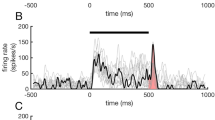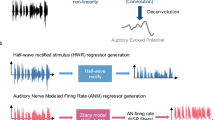Abstract
Although systems that are involved in attentional selection have been studied extensively, much less is known about nonselective systems. To study these preparatory mechanisms, we compared activity in auditory cortex that was elicited by sounds while rats performed an auditory task ('engaged') with activity that was elicited by identical stimuli while subjects were awake but not performing a task ('passive'). We found that engagement suppressed responses, an effect that was opposite in sign to that elicited by selective attention. In the auditory thalamus, however, engagement enhanced spontaneous firing rates but did not affect evoked responses. These results indicate that neural activity in auditory cortex cannot be viewed simply as a limited resource that is allocated in greater measure as the state of the animal passes from somnolent to passively listening to engaged and attentive. Instead, the engaged condition possesses a characteristic and distinct neural signature in which sound-evoked responses are paradoxically suppressed.
This is a preview of subscription content, access via your institution
Access options
Subscribe to this journal
Receive 12 print issues and online access
$209.00 per year
only $17.42 per issue
Buy this article
- Purchase on Springer Link
- Instant access to full article PDF
Prices may be subject to local taxes which are calculated during checkout






Similar content being viewed by others
References
Steriade, M., Timofeev, I. & Grenier, F. Natural waking and sleep states: a view from inside neocortical neurons. J. Neurophysiol. 85, 1969–1985 (2001).
Edeline, J.M., Dutrieux, G., Manunta, Y. & Hennevin, E. Diversity of receptive field changes in auditory cortex during natural sleep. Eur. J. Neurosci. 14, 1865–1880 (2001).
Talwar, S.K. & Gerstein, G.L. Reorganization in awake rat auditory cortex by local microstimulation and its effect on frequency-discrimination behavior. J. Neurophysiol. 86, 1555–1572 (2001).
Castro-Alamancos, M.A. Dynamics of sensory thalamocortical synaptic networks during information processing states. Prog. Neurobiol. 74, 213–247 (2004).
Moran, J. & Desimone, R. Selective attention gates visual processing in the extrastriate cortex. Science 229, 782–784 (1985).
Desimone, R. & Duncan, J. Neural mechanisms of selective visual attention. Annu. Rev. Neurosci. 18, 193–222 (1995).
Maunsell, J.H. & Cook, E.P. The role of attention in visual processing. Phil. Trans. R. Soc. Lond. B 357, 1063–1072 (2002).
Fritz, J., Shamma, S., Elhilali, M. & Klein, D. Rapid task-related plasticity of spectrotemporal receptive fields in primary auditory cortex. Nat. Neurosci. 6, 1216–1223 (2003).
Fritz, J.B., Elhilali, M., David, S.V. & Shamma, S.A. Does attention play a role in dynamic receptive field adaptation to changing acoustic salience in A1? Hear. Res. 229, 186–203 (2007).
Ghose, G.M. & Maunsell, J.H. Attentional modulation in visual cortex depends on task timing. Nature 419, 616–620 (2002).
Raz, A. & Buhle, J. Typologies of attentional networks. Nat. Rev. Neurosci. 7, 367–379 (2006).
Uchida, N. & Mainen, Z.F. Speed and accuracy of olfactory discrimination in the rat. Nat. Neurosci. 6, 1224–1229 (2003).
Yang, Y., DeWeese, M.R., Otazu, G.H. & Zador, A.M. Millisecond-scale differences in neural activity in auditory cortex can drive decisions. Nat. Neurosci. 11, 1262–1263 (2008).
Kilgard, M.P. & Merzenich, M.M. Plasticity of temporal information processing in the primary auditory cortex. Nat. Neurosci. 1, 727–731 (1998).
Wehr, M. & Zador, A.M. Synaptic mechanisms of forward suppression in rat auditory cortex. Neuron 47, 437–445 (2005).
Hubel, D.H., Henson, C.O., Rupert, A. & Galambos, R. “Attention” units in the auditory cortex. Science 129, 1279–1280 (1959).
Picton, T.W., Hillyard, S.A., Galambos, R. & Schiff, M. Human auditory attention: a central or peripheral process? Science 173, 351–353 (1971).
Fritz, J.B., Elhilali, M. & Shamma, S.A. Adaptive changes in cortical receptive fields induced by attention to complex sounds. J. Neurophysiol. 98, 2337–2346 (2007).
Scott, B.H., Malone, B.J. & Semple, M.N. Effect of behavioral context on representation of a spatial cue in core auditory cortex of awake macaques. J. Neurosci. 27, 6489–6499 (2007).
Hocherman, S., Benson, D.A., Goldstein, M.H. Jr., Heffner, H.E. & Hienz, R.D. Evoked unit activity in auditory cortex of monkeys performing a selective attention task. Brain Res. 117, 51–68 (1976).
Spitzer, H., Desimone, R. & Moran, J. Increased attention enhances both behavioral and neuronal performance. Science 240, 338–340 (1988).
Tai, L.H. & Zador, A. Neural Mechanisms of Selective Auditory Attention in Rats. PhD Thesis. Stony Brook Univ. 〈http://dx.doi.org/10.1038/npre.2008.2355.1〉 (2008).
Treue, S. & Martinez Trujillo, J.C. Feature-based attention influences motion processing gain in macaque visual cortex. Nature 399, 575–579 (1999).
Castro-Alamancos, M.A. & Oldford, E. Cortical sensory suppression during arousal is due to the activity-dependent depression of thalamocortical synapses. J. Physiol. (Lond.) 541, 319–331 (2002).
Müller-Preuss, P. & Ploog, D. Inhibition of auditory cortical neurons during phonation. Brain Res. 215, 61–76 (1981).
Eliades, S.J. & Wang, X. Neural substrates of vocalization feedback monitoring in primate auditory cortex. Nature 453, 1102–1106 (2008).
Martikainen, M.H., Kaneko, K. & Hari, R. Suppressed responses to self-triggered sounds in the human auditory cortex. Cereb. Cortex 15, 299–302 (2005).
Boly, M. et al. Baseline brain activity fluctuations predict somatosensory perception in humans. Proc. Natl. Acad. Sci. USA 104, 12187–12192 (2007).
Reinagel, P., Godwin, D., Sherman, S.M. & Koch, C. Encoding of visual information by LGN bursts. J. Neurophysiol. 81, 2558–2569 (1999).
Sherman, S.M. Thalamic relays and cortical functioning. Prog. Brain Res. 149, 107–126 (2005).
Swadlow, H.A. & Gusev, A.G. The impact of 'bursting' thalamic impulses at a neocortical synapse. Nat. Neurosci. 4, 402–408 (2001).
Massaux, A., Dutrieux, G., Cotillon-Williams, N., Manunta, Y. & Edeline, J.M. Auditory thalamus bursts in anesthetized and non-anesthetized states: contribution to functional properties. J. Neurophysiol. 91, 2117–2134 (2004).
Poulet, J.F. & Petersen, C.C. Internal brain state regulates membrane potential synchrony in barrel cortex of behaving mice. Nature 454, 881–885 (2008).
Deweese, M.R. & Zador, A.M. Shared and private variability in the auditory cortex. J. Neurophysiol. 92, 1840–1855 (2004).
Chung, S., Li, X. & Nelson, S. Short-term depression at thalamocortical synapses contributes to rapid adaptation of cortical sensory responses in vivo. Neuron 34, 437–446 (2002).
Abbott, L.F., Varela, J.A., Sen, K. & Nelson, S.B. Synaptic depression and cortical gain control. Science 275, 220–224 (1997).
Crochet, S. & Petersen, C.C. Correlating whisker behavior with membrane potential in barrel cortex of awake mice. Nat. Neurosci. 9, 608–610 (2006).
Ferezou, I., Bolea, S. & Petersen, C.C. Visualizing the cortical representation of whisker touch: voltage-sensitive dye imaging in freely moving mice. Neuron 50, 617–629 (2006).
Fanselow, E.E. & Nicolelis, M.A. Behavioral modulation of tactile responses in the rat somatosensory system. J. Neurosci. 19, 7603–7616 (1999).
Castro-Alamancos, M.A. Role of thalamocortical sensory suppression during arousal: focusing sensory inputs in neocortex. J. Neurosci. 22, 9651–9655 (2002).
Castro-Alamancos, M.A. Absence of rapid sensory adaptation in neocortex during information processing states. Neuron 41, 455–464 (2004).
Hirata, A. & Castro-Alamancos, M.A. Relief of synaptic depression produces long-term enhancement in thalamocortical networks. J. Neurophysiol. 95, 2479–2491 (2006).
Kawai, H., Lazar, R. & Metherate, R. Nicotinic control of axon excitability regulates thalamocortical transmission. Nat. Neurosci. 10, 1168–1175 (2007).
Reynolds, J.H., Chelazzi, L. & Desimone, R. Competitive mechanisms subserve attention in macaque areas V2 and V4. J. Neurosci. 19, 1736–1753 (1999).
Cook, E.P. & Maunsell, J.H. Dynamics of neuronal responses in macaque MT and VIP during motion detection. Nat. Neurosci. 5, 985–994 (2002).
Shuler, M.G. & Bear, M.F. Reward timing in the primary visual cortex. Science 311, 1606–1609 (2006).
Hromádka, T. Representation of Sounds in Auditory Cortex of Awake Rats. PhD Thesis.Cold Spring Harbor Laboratory 〈http://dx.doi.org/10.1038/npre.2008.2464.1〉 (2008).
Hromádka, T., Deweese, M.R. & Zador, A.M. Sparse representation of sounds in the unanesthetized auditory cortex. PLoS Biol. 6, e16 (2008).
Schmitzer-Torbert, N., Jackson, J., Henze, D., Harris, K. & Redish, A.D. Quantitative measures of cluster quality for use in extracellular recordings. Neuroscience 131, 1–11 (2005).
Feierstein, C.E., Quirk, M.C., Uchida, N., Sosulski, D.L. & Mainen, Z.F. Representation of spatial goals in rat orbitofrontal cortex. Neuron 51, 495–507 (2006).
Acknowledgements
This work was supported by grants from the US National Institutes of Health, the Swartz Foundation, the Marie Robertson Fund, the Louis Morin Charitable Trust and the Coleman Fung Foundation.
Author information
Authors and Affiliations
Contributions
G.H.O. and A.M.Z. designed the overall experiments and wrote the manuscript. G.H.O. designed and performed the experiments in Figures 1, 2, 4 and 6. L.-H.T. designed and performed the experiments in Figure 3 (intermodal attention). Y.Y. designed and performed the experiments in Figure 4 (head-fixed behavior).
Corresponding author
Supplementary information
Supplementary Text and Figures
Supplementary Figures 1–8, Supplementary Table 1, Supplementary Methods, Supplementary Analysis, Supplementary Data and Supplementary Model (PDF 546 kb)
Rights and permissions
About this article
Cite this article
Otazu, G., Tai, LH., Yang, Y. et al. Engaging in an auditory task suppresses responses in auditory cortex. Nat Neurosci 12, 646–654 (2009). https://doi.org/10.1038/nn.2306
Received:
Accepted:
Published:
Issue Date:
DOI: https://doi.org/10.1038/nn.2306
This article is cited by
-
Psilocybin reduces low frequency oscillatory power and neuronal phase-locking in the anterior cingulate cortex of awake rodents
Scientific Reports (2022)
-
Secondary auditory cortex mediates a sensorimotor mechanism for action timing
Nature Neuroscience (2022)
-
Choice-dependent cross-modal interaction in the medial prefrontal cortex of rats
Molecular Brain (2021)
-
Scaling of sensory information in large neural populations shows signatures of information-limiting correlations
Nature Communications (2021)
-
Subcortical circuits mediate communication between primary sensory cortical areas in mice
Nature Communications (2021)



